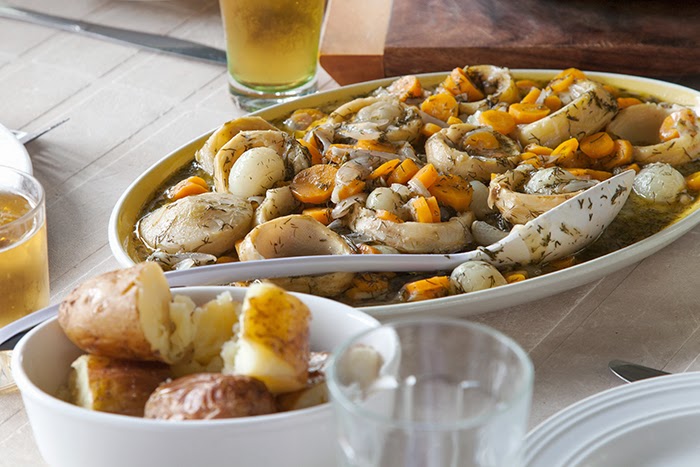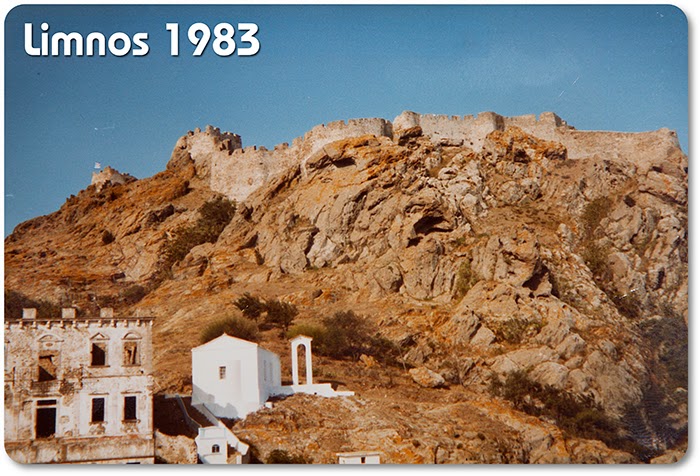It’s only been a few weeks since Tony and I were last seen whiling away the hours on the fine sands of a Greek island beach, but the distant memories of our always wonderful trips to Limnos so quickly become just that – distant memories.
We are now back in Melbourne, back to our old routines, trying to catch up on work that was put on hold while we were away, and always meaning to make time to write about the rest of our trip on the blog.
Last night I had a dream that someone had ‘burnt down’ my blog. You know how dreams are – something that makes complete sense in the dream is of course completely ridiculous in reality. But when I woke up it made me think about how upsetting it would be if my blog was to just disappear one day.
The Greek Vegetarian blog may not be the thriving space it once was, and perhaps I am the only one that visits these days, but it's reassuring to know that many of the memories and photos of our trips to Greece are stored here, as well as some silly stories I’ve put to words about my family history and experiments in the kitchen, and Tony and I love coming back here from time to time to reminisce.
It’s true I do have all the food and holiday photos stored on my computer – in fact there are so many photos I’m embarrassed to say I had to transfer most of them to several external hard-drives so that my desktop computer could keep functioning – but it’s far easier (and makes for a much more pleasant reminiscing experience) to view them in the format of a neatly laid-out blog.
Not only would I be devastated if I lost my blog, but it’s becoming increasingly depressing thinking about the prospect of looking back on a neglected blog.
Over the weekend I met someone who had been reading my blog, having heard about it from a friend of a friend. This person asked me when I would be putting up the next 'Limnos then and now' post. I was stunned that they had any interest at all in my self-indulgent project to photograph the same places in Limnos I’d visited over 30 years ago, especially given they had never been to Limnos, and weren’t even Greek.
But after seeing genuine interest in the eyes of this person, and then having my guilt and fear of losing the blog consolidating in a dream, it inspired me to set aside some time today to continue where I’d left off a few weeks ago.
As I’m sure I’ve already proclaimed, there are so many more things to tell you about our recent trip to Limnos, including recipes from my Aunt Koula and local taverna reviews. And I promise, for better or worse, these posts will slowly emerge over the coming months. But today I have Part III of the 'Limnos then and now' series to share with you. Part I can be found here, and Part II here.
It’s funny how places you know so well when viewed from a certain angle can suddenly become completely foreign when viewed from a different vantage point. This was the case with a photo I’d taken back in 1983 of the port of Myrina, Limnos' capital.
There were recognisable landmarks in the old photo that I knew still existed in Myrina, but I couldn’t understand how I’d photographed them from an angle that seemed to be a rearranged, mirror-image of my present-day perception of the scene.
It was only after visiting the area about eight times, bewildered by the conundrum before me, that I finally noticed an old seawall across the water (that has been there FOR EVER), and my narrow little mind realised that the port could actually be viewed from another angle.
It might have been 31 years since I’d walked along that seawall, but as I made my way around the port and across to the other side I was thrilled to have finally found the match for this photo.
Ironically, that very seawall was the subject of the next pair of photos. It’s not hard to miss this part of the port when you take a stroll along the cobble-stoned road, as on any given day it's likely you'll have the bejesus frightened out of you by some kid randomly jumping off the diving post and splashing loudly into the water.
Not a lot has changed here since 1983 except for a few more buildings and trees on the hills, and the absence of piled-up fishing nets on the seawall.
The fishing industry in Limnos has declined dramatically in recent years, mainly because there are very few fish left in the Aegean Sea. As a vegetarian and lover of all living beings, I don’t condone fishing of any kind, and while it’s a sad indictment that over-fishing has affected the livelihoods of many fishermen in Limnos, it’s even more deplorable how much over-fishing has affected the ecosystem of not just the Aegean Sea, but of all the oceans around the world. This documentary is a difficult watch but really opened my eyes to what the fishing industry is doing to our oceans.
Many of the images in the 'Limnos then and now' series show that not a lot changes on a traditional Greek island over a period of 30 years, but the following pair illustrates just how quickly some things can change.
On a lighter note, Tony and I have already been discussing our plans for next year's trip. Our desire to go back to Greece only gets stronger every time we return to a Melbourne winter, so talk of booking flights for our next trip usually starts around this time of year.
This time we are thinking of adding a little side-trip to Rhodes to visit George and Koula in their home town as they are not sure if they will be able to make the arduous three-flight trip from their island to Limnos next year.
We haven't made any bookings yet as we're still deciding on how our itinerary might shape up, but until then, I have around nine months to bring this blog back to a respectable state of relevance, and hopefully no one will burn it down in the meantime!
This time we are thinking of adding a little side-trip to Rhodes to visit George and Koula in their home town as they are not sure if they will be able to make the arduous three-flight trip from their island to Limnos next year.
We haven't made any bookings yet as we're still deciding on how our itinerary might shape up, but until then, I have around nine months to bring this blog back to a respectable state of relevance, and hopefully no one will burn it down in the meantime!


















































